Another week, another article about Dragon Age. I realize it might be more topical to write about Mass Effect, but I can’t help where inspiration takes me, apparently. Last time, I talked about a particular topic in the series’ lore. This time, I’d like to discuss the crunchy side – the way the series’ combat mechanics evolved.
Dragon Age: Origins
Dragon Age: Origins was marketed as a return to the classical style of the western RPG, like Baldur’s Gate. However, the tactical side of the game was far simpler. There were only three classes, and the tactical considerations resembled a simplified single-player MMO game. You needed a tank – probably a warrior with a shield. Then someone to deal damage, so a warrior with a two-handed weapon or two weapons, or a rogue. Then a mage to cast spells, and of course to heal. Most of it was tragically uninspired and simple. But there was one layer to it that was truly innovative and noteworthy: the tactics screen.
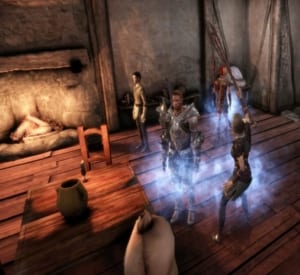
Origins had a robust tactics screen, where the player could input commands for the AI to execute. It could be as simple as a mage healing someone under 50% health, or a warrior using a taunting ability when a weaker party member is in danger. Or it can be something more complex, like setting up “if this then that” operations. This allowed the player to take advantage of tactics and planning without having to babysit the whole team. In theory, if you spent the time inputting in the tactics, the party would more or less run itself.
So, how did it work in practice? …not well. The complex tactical settings couldn’t make up for the game’s relative simplicity and bad balance problems.
First, the elephant in the room: mages. By any metric, they’re devastatingly powerful. Their regular spells are powerful enough, but it gets worse if you use spell combinations. As such, the most optimal tactic is to bring at least two mages, and have them nuke everything, while the other teammates just keep enemies occupied.
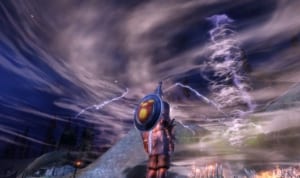
Warriors’ and rogues’ abilities are very unimpressive by comparison. Many of them rely on chance, or being very specific in your skill point allotments. The two classes share some abilities – specifically, for dual-wielding and archery styles, but shields and two-handed weapons are exclusive to warriors. It’s actually possible to build a rogue who uses a shield, but also entirely pointless. The weapon talents tended to boil down to hitting enemies a little harder than they hit you, and not much else. The class-specific ones are a bit better for most character types, but in the case of rogues they take a lot of investment for basic-seeming abilities to become available. Examples include backstabbing disabled enemies and in-combat stealth, which are so elementary that it’s baffling that they aren’t default skills.
There are also more subtle balance problems, unrelated to magic. The biggest, one is that “tank” warriors find it difficult to do their actual jobs. Using heavy armor requires a large investment in strength, which prevents them from investing in attributes that help them avoid attacks. This means that, despite using shield talents to increase their defenses, a tank’s efficiency is reliant on the mage’s ability to heal them far more than the tank’s actual efforts.
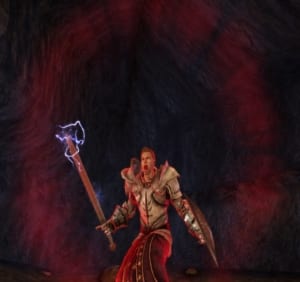
This isn’t to say warriors and rogues are useless. You do need them, or at least warriors. But the point is that the combat is very decidedly mage-centric. It doesn’t only apply to the player’s mages, either. When an enemy mage appears, they’re always the priority target, because otherwise they can decimate your team with a single fireball or chain lightning.
The best way to quickly get rid of enemy mages are, of course, your own mages. There’s a combination of spells that are guaranteed to one-shot most mages, and knock half off a boss-level mage’s health. An equally cheap option is a glyph spell that blocks all magic within it and drains mana. If you thought that giving your warriors the Templar specialization will help… best abandon that hope quickly. Logic has no place in this combat system.
A frequent counter to this sort of criticism is that mages are meant to be powerful and feared in-universe. This is true, but you can give mages a unique role in both gameplay and story without having them smash the combat balance on one knee. I’ve also seen players claim the games (the first two, that is) are single player, and thus don’t need balance. This is an entirely erroneous argument. They are single-player, but they’re also party games; you have to manage the entire team yourself. If I play a warrior or rogue, I’d rather not play second fiddle to my mage companions. I should be able to play primarily as my own protagonist character regardless of what class I choose.
All in all, the combat in Dragon Age: Origins might seem varied and interesting at first, and to some degree it can be. It is simple and elegant, with a strong foundation, but there’s a lot of cracks in it. There is a ‘right’ way to play Dragon Age: Origins, and if you don’t know what it is, you can end up not being able to finish the game. Thankfully, these issues were less prominent in later titles.
Dragon Age 2
The second installment of the series proved controversial in more ways than one, and a big part of the controversy was how much it changed the combat. However, I personally think a lot of the controversy stems from aesthetics – tactically, it is not only similar to Origins, but also significantly improves on it.
What makes me say that? It comes down to improved balance and increased interplay. Mages no longer dominate play, and all three classes have their own tricks to pull off. While the game sadly keeps the warrior/rogue/mage division, each class has a more consistent niche. Warriors who use shields are still tanks, but those that use two-handed weapons stand out from rogues with their focus on attacking many enemies at once.
Mages no longer dominate encounters with their spells, but they’re still essential for their ability to strike entire areas, support and heal. Healing is also not as absolutely crucial as it was previously– it’s possible to run encounters without a mage, or with a mage who can’t heal. Rogues remain the heavy hitting damage-dealers they were before, but then this class seems to be the easiest to balance in the entire series.
Spell combos return as cross-class combos, which is a major upgrade. Each class can inflict a specific status effect – warriors stagger, rogues disorient, and mages make enemies brittle. The other two classes can exploit those statuses for massive damage and debilitating effects. Well, mostly the former, unfortunately, but it does result in having to combine different classes’ abilities. This leads to a better sense of cooperation between the party that’s deeper than “warrior taunts bad guys and mage heals the warrior.”
The abilities themselves are more engaging both visually and functionally, particularly for warriors and rogues. There’s still plenty of talents that boil down to pure damage, but there’s also far more movement across the battlefield, area effects, ways to recover stamina, hide or cause enemies to miss.
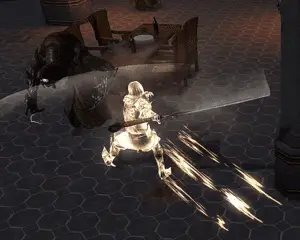
In terms of character building, ability trees are actual trees now, rather than straight lines of four abilities each. Warriors and rogues get more abilities that are independent of the weapons they use. The most welcome change is unique specializations for your companions, not just you – this means that I could actually make my Fenris different from my Hawke, even though they are both warriors with a two-handed weapon.
The tactics screen remains the same, but there are subtle changes to the general feel of the controls. They shift from the 3/4th overhead control of Origins to a third-person scheme where you focus on Hawke. This combines with the flashy cinematic aesthetics of the combat to make it seem like the game is more of a hack ‘n’ slash than it actually is. The quicker animations are certainly a godsend after Origins‘ slow, ponderous swinging and half-hearted poking.
While I believe Dragon Age 2’s combat is the best in the series, it’s by no means perfect. It clings to the genre restrictions the series chose to burden itself with, like the outdated, limited class scheme. I mentioned only two types of warriors before, because warriors can no longer dual wield. Rogues can only use daggers and no other melee weapons, while warriors now can’t equip bows. Granted, only dual-wielding warriors are an actual lost option – rogues who use anything but daggers in melee, as well as archery for warriors, were mostly there for show. But it’s not very commendable to remove less-optimal options, rather than make them work. It’s not like Origins had a lot of possibilities for warriors and rogues to begin with.
Furthermore, Dragon Age 2 shoots itself in the foot with its encounter design. As if worried that the faster animations would make the game too quick, the designers ruthlessly padded every fight. Every random encounter (of which there are many) will involve at least two waves of trash mobs, which come out of literally nowhere. The more serious enemies have inflated health pools that makes fighting them a lengthy grind. It’s especially bothersome in the early game, where you only have a few abilities; it means a lot of auto-attacking while you wait for the cooldowns to end. Later on, you can combine your talents and spells to produce enough damage to punch through the bloat… sometimes.
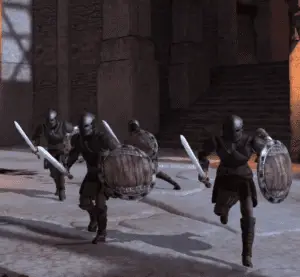
There’s a lot of solid work to Dragon Age 2‘s combat, but it’s very much a diamond in the rough.
Dragon Age: Inquisition
The latest game in the series takes the evolution of the combat in a different, strange direction. It resembles Dragon Age 2, but it also does not.
Inquisition follows from Dragon Age 2 in that it makes the combat even more action-oriented. The action-like feel of Dragon Age 2 came from camera angles and controls. Inquisition explicitly moves towards action mechanics. The controls are much more geared towards controlling your Inquisitor only. There are many more abilities that require active timing, like blocking and parrying. There are far fewer active abilities for all classes, and you are restricted to a set number of slotted abilities rather than having access to all of them at once.
What it results in is a game that straddles the fence between a more traditional tactical RPG, and an action-RPG like Dark Souls or The Witcher. But it’s not actually either of those.

Visually, Inquisition seems to strike a balance between Origins‘ dreadfully stiff animations and Dragon Age 2‘s high-action, slightly ludicrous style. It’s still firmly in the realm of improbable moves, but not to the degree Dragon Age 2 did it. Archery rogues, especially, no longer cause a rain of arrows to fall down, or send an arrow straight through the battlefield. Two-handed weapons are back to their pathetic state from Origins, because there are enough people who have no idea how they work, but think they do. They’re effective – just horrendously ugly.
Inquisition is also the first game in the series to introduce multiplayer, and I think it might be the source of the new direction. The controls are suited for commanding a single character, with every other party member also being under the control of a living person. This might not be such a big problem if it weren’t for the gutting of the previous games’ tactics screen. You can set some party behaviors, but it’s a pale shadow of what it was before.
Which, unfortunately, makes for a very chaotic combat experience. The AI simply isn’t smart enough to use all its abilities well, so combat requires the player to take a very active approach. So you control your Inquisitor and hope the AI doesn’t get itself killed. Picking your companions’ abilities is driven by what the AI can effectively use, rather than actual usefulness. For example, it makes archer rogues a lot better than dagger rogues, since an archer doesn’t need specific positioning.
The game does make some marked improvements, however, and the major one is healing. Spells that restore health are gone; you can only regain health by drinking potions, which come in limited supply, and can only be refilled at camps. Healing spells are replaced with more barriers and guard abilities. Mages apply barriers, which then act as an extra layer of health. Guard is generated by warriors and acts similarly, with the difference that it doesn’t disappear by itself.
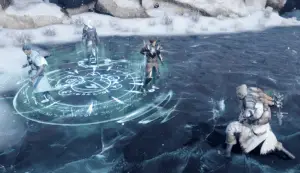
This shifts the focus from refilling missing health to actively mitigating and avoiding damage, which is a welcome change. It’s still not perfect – it’s easy to generate so much guard that many battles become trivial. But it’s a step in the right direction.
I spoke dismissively of the multiplayer, but it does seem to break some of the single-player’s rules. While characters are divided into the warrior/mage/rogue categories, they get their own ability sets – only two each, but much larger than the single-player ones. More importantly, these trees can mix and match abilities from different sets, and even different classes.
Going Forward
Where would I like future Dragon Age games to go? First off, they need to decide what they are. Tactical RPGs, action RPGs, or something entirely different? Inquisition awkwardly tries to be both, and it really doesn’t do it any favors.
I think staying as a tactical RPG would serve the game series best. If it did return to this root, it should look back to what Dragon Age 2 got right, and what it didn’t. The improved balance and interplay was good; needlessly padded encounters and unnecessarily flashy animations were not.
The games could do much more than just stick to what worked before, though. What they really need to do in order to achieve their full potential is to break away from the traditional combat mechanic restrictions the genre imposes on them. The Warrior/Mage/Rogue division is stifling and arbitrary, particularly for warriors and rogues. Neither “warrior” nor “rogue” really mean anything. However, you can’t get rid of the class system altogether, because the series probably wouldn’t work with an entirely classless system.
Classes that more accurately describe the role that the character plays in their team would be a better design choice. More fighting styles for non-mages would also be an absolute necessity for the combat to work. More varieties of magic than “wave a stick around and make magic happen” wouldn’t hurt, either; being a mage needs to mean more than just being able to cast spells. The Knight-Enchanter specialization is a step in the right direction for this, but it just needs capitalizing on.
I don’t hold out much hope that it will happen – BioWare is very wary of backlash. But it’s something I think could help make combat in the games something to look forward to, rather than a tolerable distraction in between the story moments.

